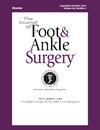Assessment of peroneal tendon lesions using 2-dimensional and 3-dimensional isotropic magnetic resonance imaging with surgical correlation
IF 1.3
4区 医学
Q2 Medicine
引用次数: 0
Abstract
Accurate diagnoses of peroneal pathologies remains a challenge due to limitations of conventional 2D (dimensional) imaging, which can impact long-term patient outcomes. This study evaluates MRI accuracy and inter-reader reliability of peroneal compartment pathology for 2D and 3D MRI. A consecutive series of patients who underwent peroneal compartment surgery with preoperative 1.5- or 3.0-Tesla ankle MRIs from 2009 to 2024 included 32 scans (22 with 2D, 10 with 2D+3D) from 31 patients (ages 17–74 years, all genders). Three musculoskeletal readers blinded to surgical findings independently analyzed MRI scans for common peroneal tenosynovitis, peroneus brevis and peroneus longus tenosynovitis, tendinopathy, and tears. Inter-reader reliability and diagnostic performance measures were calculated. Using majority vote, overall accuracy, sensitivity, and specificity for peroneal tendons using 2D MRI were 80%, 81%, and 79%, respectively. Using 3D MRI sequences, whether in isolation or combination with 2D MRI, accuracy, sensitivity, and specificity increased to 85%, 88%, and 83%, respectively. The inter-reader reliability for peroneus brevis lesions was 0.45-0.75 for 2D, 0.25-0.35 for 3D, and 0.31-0.54 for combined 2D+3D, while for peroneus longus lesions, it was 0.45-0.90 for 2D, 0.20-0.71 for 3D, and 0.64-0.81 for combined 2D+3D scans. The inter-reader reliability for tenosynovitis ranged from 0.62-0.64 for 2D, 0.25-0.37 for 3D, and 0.57-0.66 for combined 2D+3D scans. The addition of 3D MRI to 2D high-resolution ankle MRI protocol or 3D MRI alone increases accuracy of peroneal compartment lesion detection with minor decrease in inter-reader reliability for peroneal brevis tendon assessment. Larger studies may help validate our findings.
利用二维和三维各向同性磁共振成像与手术相关评估腓肌腱病变。
由于传统二维成像的局限性,准确诊断腓骨病变仍然是一个挑战,这可能会影响患者的长期预后。本研究评估了二维和三维MRI对腓骨室病理的MRI准确性和读者间可靠性。从2009年到2024年,连续进行腓骨筋膜室手术的患者术前进行1.5或3.0特斯拉踝关节mri,包括31例患者(年龄17-74岁,所有性别)的32次扫描(22次2D, 10次2D+3D)。三位对手术结果不知情的肌肉骨骼读者独立分析了普通腓骨腱鞘炎、腓骨短肌和腓骨长肌腱鞘炎、肌腱病变和撕裂的MRI扫描。计算了阅读器间可靠性和诊断性能指标。采用多数投票法,2D MRI对腓骨肌腱的总体准确性、敏感性和特异性分别为80%、81%和79%。使用3D MRI序列,无论是单独使用还是与2D MRI结合使用,准确性、敏感性和特异性分别提高到85%、88%和83%。对于腓骨短肌病变,2D扫描的读取器间信度为0.45-0.75,3D扫描的为0.25-0.35,2D+3D联合扫描的为0.31-0.54,而对于腓骨长肌病变,2D扫描的为0.45-0.90,3D扫描的为0.20-0.71,2D+3D联合扫描的为0.64-0.81。腱鞘炎二维扫描的读取器间可靠性为0.62-0.64,三维扫描为0.25-0.37,二维+三维联合扫描为0.57-0.66。在2D高分辨率踝关节MRI方案中加入3D MRI或单独使用3D MRI可提高腓骨筋室病变检测的准确性,但读卡器间对腓骨短肌腱评估的可靠性略有降低。更大规模的研究可能有助于验证我们的发现。
本文章由计算机程序翻译,如有差异,请以英文原文为准。
求助全文
约1分钟内获得全文
求助全文
来源期刊

Journal of Foot & Ankle Surgery
ORTHOPEDICS-SURGERY
CiteScore
2.30
自引率
7.70%
发文量
234
审稿时长
29.8 weeks
期刊介绍:
The Journal of Foot & Ankle Surgery is the leading source for original, clinically-focused articles on the surgical and medical management of the foot and ankle. Each bi-monthly, peer-reviewed issue addresses relevant topics to the profession, such as: adult reconstruction of the forefoot; adult reconstruction of the hindfoot and ankle; diabetes; medicine/rheumatology; pediatrics; research; sports medicine; trauma; and tumors.
 求助内容:
求助内容: 应助结果提醒方式:
应助结果提醒方式:


